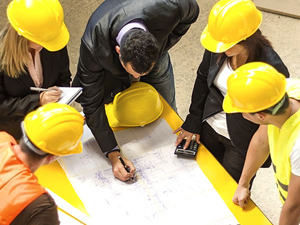
Described
by the NEC as an ‘evolution, not a revolution’, the NEC4 builds on the success
as well as the content of the NEC3 to achieve further improvements. Alusani® Course Leader, Cameron Staude, says
that most of South Africa’s state-owned enterprises,
including Transnet and Eskom, are predominantly rolling out contracts based on
the NEC3 suite of contracts.
“While the Construction
Industry Development Board’s regulations haven’t been updated since 2015, they
do prescribe that the latest contract be used. Currently, the latest contracts
that are at our disposal are FIDIC 2017, JBCC 6.2, GCC 2015, and NEC4,” says
Staude.
This
makes it essential for professionals in the built environment to quickly get up
to speed on all its new features.
“The
project team involved in the R4.4-billion MeerKAT radio telescope project,
which will eventually become part of the Square Kilometre Array, is leaning
towards using the NEC4 contract suite. The
progressive nature of the contract, combined with its appeal on large projects
where there are international stakeholders, made NEC4 the contract of choice,”
says Staude.
Many
of the new features of the NEC4 contract allow for greater flexibility. There
are also two new forms of contract, namely the NEC4 Design, Build and Operate
Contract (DBO) and the NEC4 Alliance Contract (ALC), providing an even greater
range of potential contract and procurement solutions for clients who are
undertaking projects and works programmes.
“One
of the interesting features in NEC4 is a clearly stipulated process for the
Early Warning system, which is a mechanism where the Project Manager or Contractor
notifies relevant parties of a potential risk before they occur so that the
parties can avoid or mitigate the risk. In NEC3, there was uncertainty about
the steps that the Project Manager had to take if a potential risk was picked
up, but NEC4 gives clear guidance on how these situations should be handled,”
says Staude.
NEC4 stipulates that the Project
Manager prepares the first Early Warning Register and issues it to the Contractor within one week of the
starting date. The Project
Manager instructs the Contractor
to attend the first early warning meeting within two weeks of the starting date. Later
early warning meetings are held if either the Project Manager or the Contractor
instructs the other to attend and at any case at no longer intervals than the
intervals stated in the Contract Data until Completion of the whole of the works.
“The NEC4 encourages a
collaborated approach, instead of a regimented one. The way that the processes
have been clearly defined ensures that there is a regular commercial management
process for the project, which will benefit all parties involved,” says Staude.
The
NEC4 also provides two incentives for the Contractor which didn’t exist under
pricing Options A and B of NEC3. NEC4
has introduced a Contractor’s Proposal where it can make proposals to reduce
the Employer’s Prices whilst sharing in a pre-agreed percentage of the sharing
as well as a proposal for acceleration to reduce the Completion Date. Further
the NEC4 now provides for a final payment certificate as well as a new dispute
resolution process where disputes are hopefully avoided.
“Regardless
the size or type of project, the NEC4 contract can work for you. I’m here to
give you the practical advice you need on how to effectively make the
transition from NEC3 to NEC4,” concludes Staude.
Cameron
will be presenting CPD-accredited NEC3 & NEC4 training courses in
Johannesburg and Durban. Please contact Alusani® for upcoming course dates.
©2019
Copyright Alusani Skills & Training Network®. All Rights Reserved.
Unauthorised reproduction will be actionable under South African law.



